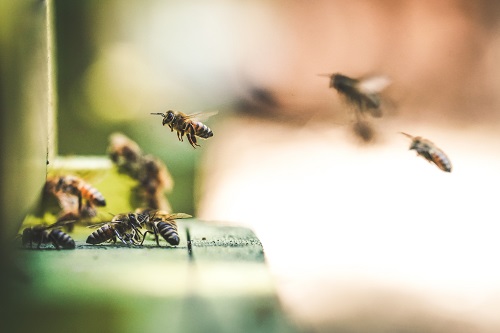Want to Repel Flies, Mosquitoes and Bugs Organically? Here Are 10 Incredible Plants For the Job
We do know how harmful the excess usage of insecticides can be for our bodies. But did you ever think how much the usage of these insecticides can be reduced if we grow certain plants and flowers that can naturally repel flies, mosquitoes, and bugs? Some plants contain the properties of either repelling harmful insects and pests or attracting beneficial ones. Ladybugs and mantis are the perfect examples. Well, this is how it works: the beneficial ones prey on the harmful ones while eliminating their existence.
You can consider these tiny helpers of Mother Nature as yours, that assist in relieving your workload. Keep the bug and mosquitoes away from pestering you by growing these particular plants in your yard while you enjoy the peaceful afternoon sun on your patio. Consider these particular plants as the undercover agents in your garden. They will appear to be working for beautifying your garden when in fact, they are being watchful for any underhand activity that will damage it. Having said that, some plants might work for one garden while not being suitable for the other at the same time. The climates, the hardiness, the soil, and many more, every little aspect matters. Do your research before drawing any conclusion and then select the plants that will work the best for you.
You might want to read this useful article on how to get rid of flies on my patio. DIY tips and other options.
These listed plants have the properties of repelling flies and other harmful insects from your garden. Read and benefit from our list. So get your troops ready because it is time for some action.
1. Basil
A naturally occurring organic fly and mosquito repellant, what more could you ask for. Basil is an aromatic herb that is used widely for adding flavor to culinary purposes. This is an extremely easy-to-grow herb that can be planted in your yard as well as in your kitchen. Basil can be grown both via hydroponics and in the soil. Propagating is also very trouble-free and efficiently successful. Pruning the plant will make the foliage become more dense and lush.
There are numerous varieties of basil. But the one that is the most efficient in keeping flies away is the sweet basil. Grow them in a hanging basket or simply keep them on your patio to repel the flies from entering your home. Planting it near your vegetable garden can keep the pests from attacking your vegetables.
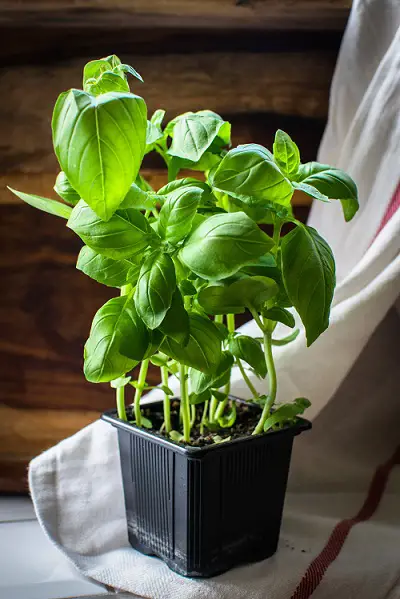
The oils from the leaf basically act as insect repellents. So for that purpose simply bruise a leaf, rub it onto your skin, and voila! Flies won’t bug you (quite literally). When the foliage of this herb is moved, the essential oils released commonly known as the fly bane, repel the insects.
2. Tansy
Tansy is a perennial flowering plant that is also an excellent insect repellent that includes flies and mosquitoes. Not so famed, this herb resembles marigolds quite much. Tansy is a fast-growing plant that is drought tolerant once grown up. It requires full sun. We can say that it is a neglect tolerant plant that rewards you with great foliage and yellow flowers that come back every year.
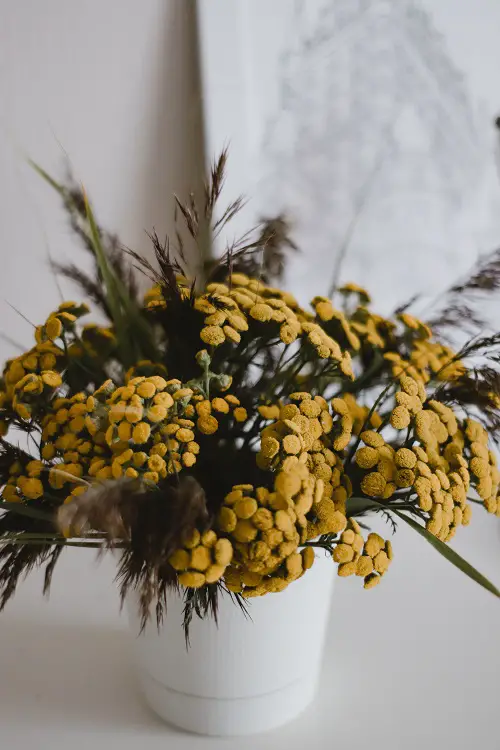
Tansies have this essential oil in them which is so toxic that it can be fatal for not only insects but also animals and humans. If less lethal, it can cause a severe allergic reaction by only touching the leaves. In earlier days tansy it is said to be used to cure illnesses, but this has no scientific proof as it is a toxic herb.
But that is not all. Tansies have their good side too. They are known to be excellent companion plants for various crops like cabbage, kale, cauliflower, cucumbers, squash, and even potatoes. The bright yellow pollen-enriched flowers attract a lot of insects for pollination while the camphor-smelling foliage helps in keeping the pests away from your vegetable patch. We suggest growing tansies in containers or bounded areas as they can become quite invasive.
3. Mint
Who is not familiar with this herb called mint. Majorly known for the fresh breath it gives and the cooling sensation that it brings in the mouth. The name itself is enough to make you cool down in the hot summers. Mint is a herb that is widely used for flavoring various cuisines and as condiments. Not only that but there are numerous counts of illnesses that can be cured with mint. Particularly used for digestion purposes, mint leaves are rich in fiber, vitamin A and various other nutrients. Mint herbal tea is an excellent remedy for chronic digestive problems.
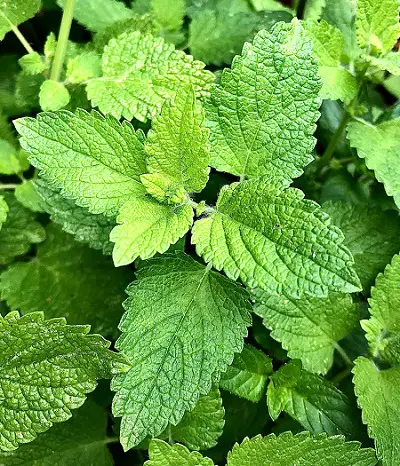
Mint is a very efficient insect repellant. Flies, mosquitoes, fleas, and even mice stay away from where mint is planted. At the same time, the fragrant herb attracts insects and pests that are good for your garden. This highly fragrant and leafy plant is very easy to grow through hydroponics and in soil. This is a must addition in your kitchen garden where you can plant it in small jars or containers or in your vegetable patch. Very easy growing, this herb requires full sun to grow. Just beware of its invasive nature as this is a very fast-growing plant that will take over the flower beds in your garden.
With these 8 must-have plants to increase oxygen level in the house, you can bring serenity and increase oxygen levels.
4. Marigold
Did not know what wonderful things your marigolds were capable of? Yes, they are efficient fly and mosquito repellants in addition to being beneficial for healing eczema and sunburn and so much more. They release limonene (a chemical found in citrusy stuff) that slows the flies down.
Grow marigolds around the edges of your flower beds for added beauty in your garden. These are annual, sun-loving plants that love the winter sun in particular. The unique pungent fragrance of the flower makes it a good companion plant with most vegetables like chili pepper, tomatoes, and potatoes. Planting marigolds near your vegetable patch can help you protect your vegetables (tomatoes) from root-knot nematodes attacks. This fragrance keeps the pests from attacking these vegetables.
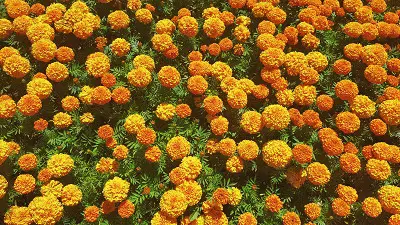
The flowers are also known to be edible but you have to be tactful while watering them. Make sure that you water them at the base and not the overhead. The densely petaled flowers may become a target of rot because of water collecting in the flowers. Allowing the soil to dry in between watering is a good option. But in high heat temperatures, make sure the blooms don’t dry up because of less watering.
Recommended article- Most Fragrant Flower Plants That Will Add Sweet Scents to Your Garden
5. Sweet Woodruff
Sweet woodruff that is also known as sweet-scented bedstraw is a perennial flowering plant with clusters of tiny white flowers that blooms in spring. An edible plant that somewhat tastes like vanilla, sweet woodruff is known for its fragrance and is used as an air freshener and insect repellant. It is a good idea to plant them in those spots in your garden which you want to cover, and they can make wonderful flower beds. But select a shady spot to grow sweet woodruff. They like moist, well-drained, and nutrient-rich soils.
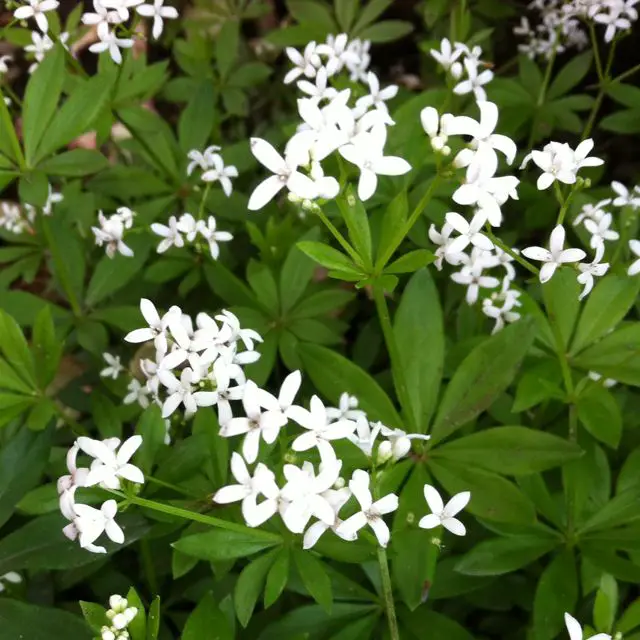
Other than that it has great medicinal values (we suggest consulting a doctor before handling anything related to medicines). Sweet woodruff is quite invasive (when growing conditions are right) and can quickly take over the surrounding areas where you plant them. If planted in beds, use the spade edging method to control the expansion.
6. Lavender
With ever most stunning lilac blooms, lavender is a very famous plant known for its calming and soothing effect on the human brain. The strong aroma actually repels flies, fleas, and other destructive insects. You can use fresh lavender stalks as well as dried ones to repel bugs away from your house. Keep the dried lavender in your room to drive away bed bugs as they can’t survive its fragrance and taste. Even mice detest the lavender smell. So if your garden or house is infested by mice, then we suggest planting these in your yard to get rid of them without having to use the harmful chemicals.
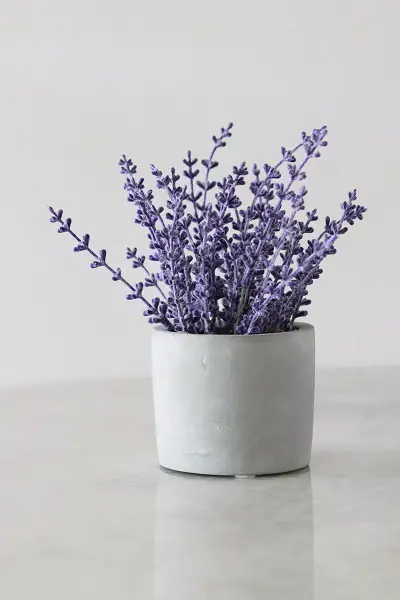
Lavender is an outdoor growing plant that can be grown for ornamental purposes as well. It’s hard to grow them indoors even if you live in winter hardy areas. Lavender grows best in full sun and well-drained soil that has organic compost added to it.
Lavender contains certain elements that are toxic to pets and may cause skin allergic reactions in small children. Although for adult humans, it is vastly used for calming via aromatherapy and treating various other illnesses.
7. Rosemary
A herb that can add the most wholesome flavors to your cooking, rosemary with its needle-like foliage is very easy to grow. You can grow this in jars inside your kitchen as well. It is a perennial herb that blooms blue or white flowers. Rosemary has the tendency to attract beneficial creature like hummingbirds and bees which promote pollination. Just give it full sun exposure and a well-drained, moist nutrient-rich soil, and your plant is good to go.
Rosemary is great for adding flavors to your food as well as repelling flies and insects. Like lavender, this plant emits a particular aroma that is disliked by flies, fleas, and mosquitoes. They can be companion plants for your vegetables to control pest attacks, especially the cabbage moths and carrot flies.
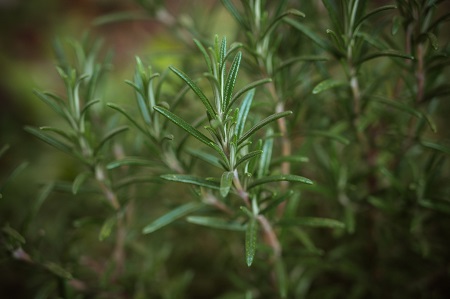
An exceptional source of anti-inflammatory properties, rosemary is used to treat various skin and hair issues. It boosts immunity and helps improve memory loss.
8. Lemongrass
Lemongrass is a tropical herb that grows best in full sun and warm temperatures. Lemongrass is a fast grower that also spreads quickly and can reach up to the height of 3 to 5 feet tall in the growing season.
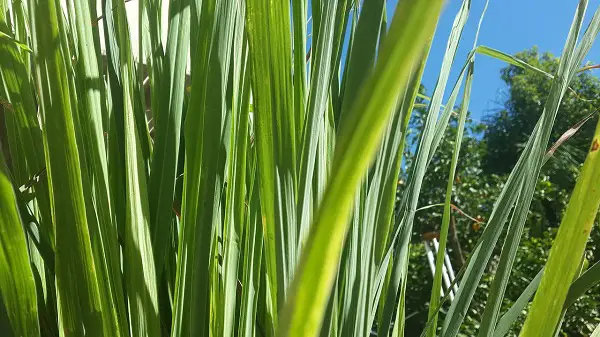
Lemongrass emits a citrusy fragrant from its lemony foliage that keeps the flies and mosquitoes away. Bruising the grassy leaves can result in the excretion of lemongrass oils. When these are rubbed onto the skin, they act as good insect repellents. Lemongrass can be planted in an open area in your yard or in any container that can be placed indoors or on your patio. This will prevent flies from entering your home.
Lemongrass is also a great antioxidant. It is known to prevent the growth of some bad bacteria and yeast. It also contains fever-reducing elements, improves sugar and cholesterol levels in the blood, and relieves pain and swelling.
With this article, you may give your plant extra attention to keep it in a flourishing state: Which is the best fertilizer for garden plants? Artificial or organic, which one to choose?
9. Venus Flytrap
Known to be a fly eating machine, plant Venus flytrap where you want to get rid of pestering, buzzing-in-your ear flies and mosquitoes. It’s a very unique-looking plant, almost resembling a dragon mouth with big teeth. It has very sweet tasting nectar on the inside of its two lobes. The files come in, thinking they are in for a treat but little do they know that they are actually themselves the treat. The lobes close immediately, trapping the fly in and gobbling it down with the help of certain enzymes. As weird as it may sound, this flowering plant is famous for its carnivorous eating habits. When growing in the wild, they can even eat reptiles and rodents.
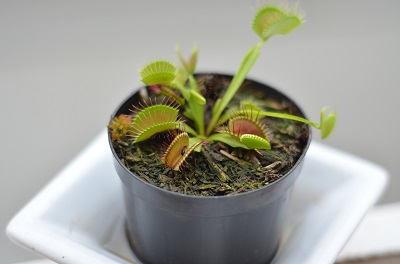
Venus flytrap grows best in moist and acidic soils and needs full sun. If planted outdoors, they survive in winters only. Grow it in a pond, keeping the head away from the water, or grow them in pots and containers to place them on your patio.
10. Citronella
An authentic citronella plant has grass-like foliage but definitely much much longer in height. We write authentic because this grassy plant is a little difficult to find as it is often mixed up with other plants like geranium. Citronella may also be confused with lemongrass. They look the same and smell the same but the only difference is that citronella is not okay for consumption while lemongrass can be consumed as herbal tea.
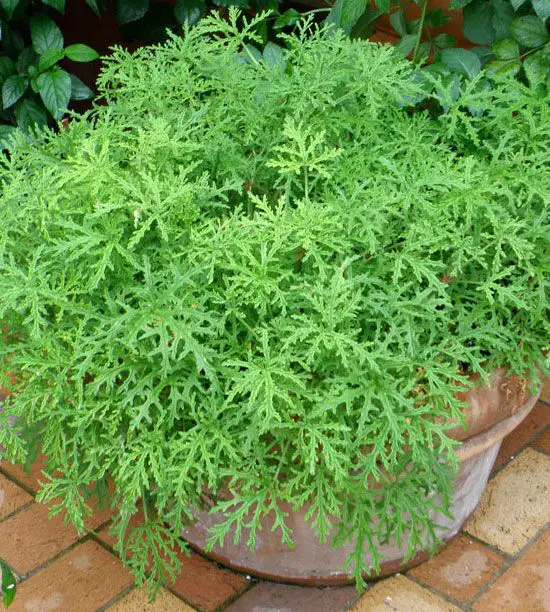
Citronella, belonging to the same family as lemongrass, has that lemony scent that drives insects like flies and mosquitoes insane. Oil derived from this plant is a biochemical pesticide. When used topically on human skin, it does not cause any allergic or harmful reactions.
Give this plant a warm temperature and full sun to thrive. A well-drained moist soil works best for growing this plant. Citronella is considered toxic for pets, so pet owners be watchful!
It’s about time you plant these natural fly repelling plants and get rid of the fly swatter. Flies buzzing around your head and infinitely annoying you will definitely be a thing of the past.
Recommended Article- Which is The Best Fertilizer for Garden Plants? Artificial or Organic, Which One to Choose?

